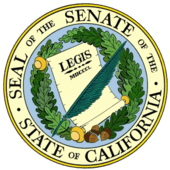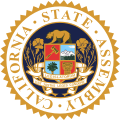California State Legislature
| California State Legislature | |
|---|---|
| 2015–16 session | |
 | |
| Type | |
| Type | |
| Houses |
Senate Assembly |
| Leadership | |
Senate Minority Leader | |
Assembly Minority Leader | |
| Structure | |
| Seats |
120 40 senators 80 assembly |
 | |
Senate political groups |
|
 | |
Assembly political groups |
|
| Elections | |
Senate last election | November 8, 2016 |
Assembly last election | November 8, 2016 |
| Meeting place | |
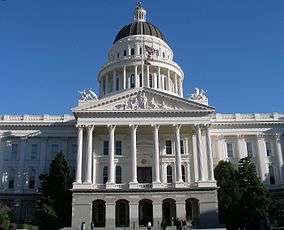 | |
|
California State Capitol Sacramento, California | |
| Website | |
|
www | |
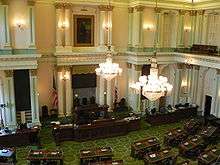
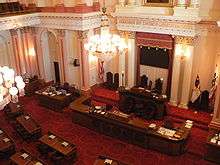
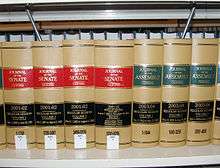
The California State Legislature is the state legislature of the U.S. state of California. It is a bicameral body consisting of the lower house, the California State Assembly, with 80 members, and the upper house, the California State Senate, with 40 members.[1] New legislators convene each new two-year session, to organize, in the Assembly and Senate Chambers, respectively, at noon on the first Monday in December following the election.[2] After the organizational meeting, both houses are in recess until the first Monday in January, except when the first Monday is January 1 or January 1 is a Sunday, in which case they meet the following Wednesday. Aside from the recess, the legislature is in session year-round.[3]
The state senate currently consists of 26 Democrats and 14 Republicans, and the Assembly consists of 52 Democrats and 28 Republicans. Except for the period from 1995 to 1996, the Assembly has been in Democratic hands since the 1970 election (even while the governor's office has gone back and forth between Republicans and Democrats). The Senate has been in Democratic hands continuously since 1970.
State House
Since California was given official statehood by the U.S. in September 9, 1850 as part of the Compromise of 1850,[4] the state capital was variously San Jose (1850–1851), Vallejo (1852–1853) and Benicia (1853–1854), until Sacramento was finally selected in 1854.
The first Californian State House was originally a hotel in San Jose owned by businessman Pierre "Don Pedro" Sainsevain and his associates.[5]
The State Legislature currently meets in the California State Capitol in Sacramento.
Terms and term limits
Members of the Assembly are elected from 80 districts and serve two-year terms. Members of the Senate are elected from forty districts and serve four-year terms. Twenty Senate seats are up for election at each two-year election cycle.[1]
Term limits were initially established in 1990 following the passage of Proposition 140.[3] In June 2012, voters approved Proposition 28[6] which allows legislators to serve a maximum of 12 years without regard to whether the years are served in the State Assembly or the State Senate. Legislators first elected on or before June 5, 2012 are restricted by the previous term limits, approved in 1990, which limited legislators to three terms in the State Assembly and two terms in the State Senate.
Recordkeeping
The proceedings of the California State Legislature are briefly summarized in regularly published journals, which show votes and who proposed or withdrew what.[7] Reports produced by California executive agencies, as well as the Legislature, were published in the Appendices to the Journals from 1849 to 1970.[8] Since the 1990s, the legislature has provided a live video feed for its sessions, and has been broadcast statewide on the California Channel and local Public-access television cable TV. Due to the expense and the obvious political downside, California did not keep verbatim records of actual speeches made by members of the Assembly and Senate until the video feed began. As a result, reconstructing legislative intent outside of an act's preamble is extremely difficult in California for legislation passed before the 1990s.
Since 1993, the Legislature has hosted a web/ftp site in one form or another, of which the current version is located at leginfo.public.ca.gov, which contains the text of all statutes, all bills, the text of all versions of the bills, all the committee analyses of bills, all the votes on bills in committee or on the floor, and veto messages from the Governor. Before then, committees occasionally published reports for significant bills, but most bills were not important enough to justify the expense of printing and distributing a report to archives and law libraries across the state. For bills lacking such a formal committee report, the only way to discover legislative intent is to access the state archives in Sacramento and manually review the files of relevant legislators, legislative committees, and the Governor's Office from the relevant time period, in the hope of finding a statement of intent and evidence that the statement actually reflected the views of several of the legislators who voted for the bill (as opposed to just one).
Legislative committees
The most sought-after legislative committee appointments are to banking, agriculture and insurance. These are sometimes called "juice" committees, because membership in these committees often aids the campaign fundraising efforts of the committee members, because powerful lobbying groups want to donate to members of these committees.[9]
Overview of legislative procedure
A bill is a proposal to change, repeal, or add to existing state law. An Assembly Bill (AB) is one introduced in the Assembly; a Senate Bill (SB), in the Senate.
Bills are designated by number, in the order of introduction in each house. For example, AB 16 refers to the 16th bill introduced in the Assembly. The numbering starts afresh each session. There may be one or more "extraordinary" sessions. The bill numbering starts again for each of these. For example, the third bill introduced in the Assembly for the second extraordinary session is ABX2 3. The name of the author, the legislator who introduced the bill, becomes part of the title of the bill.
The legislative procedure, is divided into distinct stages:[10]
- Drafting. The procedure begins when a Senator or Assembly Member decides to author a bill. A legislator sends the idea for the bill to the California Office of the Legislative Counsel, where it is drafted into bill form. The draft of the bill is returned to the legislator for introduction.
- Introduction or First Reading. A bill is introduced or read the first time when the bill number, the name of the author, and the descriptive title of the bill are read on the floor of the house. The bill is then sent to the Office of State Publishing. No bill except the Budget Bill may be acted upon until 30 days have passed from the date of its introduction.
- Committee hearing. After introduction, a bill goes to the rules committee of the house, where it is assigned to the appropriate policy committee, appropriate to the subject matter, for its first hearing. During the committee hearing the author presents the bill to the committee, and testimony may be heard in support or opposition to the bill. The committee then votes on whether to pass the bill out of committee, or that it be passed as amended. Bills may be amended several times. It takes a majority vote of the committee membership for a bill to be passed and sent to the next committee or to the floor.
- Fiscal committee. If the bill which contains an appropriation or has financial implications for the state.
- Second reading. A bill recommended for passage by committee is read a second time on the floor of the house. Ordinarily there is little or no debate. If a bill is amended at this stage, it may be referred back for another committee hearing.
- Floor vote. A roll call vote is taken. An ordinary bill needs a majority vote to pass . An urgency bill or a bill with tax increases requires a two-thirds vote. The California Constitution used to require a two-thirds vote of both houses on the yearly budget and on any bill which would increase taxes, but since the passage of California Proposition 25 (2010), the two-thirds vote is required only for tax increases.[11] Before, this provision was faulted for much of what had been termed "legislative gridlock",[12] enabling a minority party to block approval of a budget before the previous one expired.[b 1]
- Second house. If it receives a favorable vote in the first house, a bill repeats the same steps in the other house. If the second house passes the bill without changing it, it is sent to the governor's desk.
- Resolution of Differences (concurrence or conference). If a measure is amended in the second house and passed, it is returned to the house of origin for consideration of amendments. The house of origin may concur with the amendments and send the bill to the governor or reject the amendments and submit it to a two-house conference committee. If either house rejects the conference report, a second (and even a third) conference committee can be formed. If both houses adopt the conference report, the bill is sent to the governor.
- Governor's action. Within 30 days after receiving a bill, the governor may sign it into law, allow it to become law without his/her signature, or veto it.
- Overrides. A vetoed bill is returned to the house of origin, where a vote may be taken to override the governor's veto; a two-thirds vote of both houses is required to override a veto.
- California Law and effective date. Each bill that is passed by the Legislature and approved by the Governor is assigned a chapter number by the Secretary of State. These chaptered bills are statutes, and ordinarily become part of the California Codes. Ordinarily a law passed during a regular session takes effect January 1 of the following year. A few statutes go into effect as soon as the governor signs them; these include acts calling for elections and urgency measures necessary for the immediate preservation of the public peace, health, or safety.
Sessions
- California State Legislature, 2015–16 session
- California State Legislature, 2013–14 session
- California State Legislature, 2011–12 session
- California State Legislature, 2009–10 session
- California State Legislature, 2007–08 session
- California State Legislature, 2005–06 session
- California State Legislature, 2003–04 session
- California State Legislature, 2001–02 session
- California State Legislature, 1999–2000 session
- California State Legislature, 1997–98 session
- California State Legislature, 1995–96 session
See also
- Bill (proposed law)
- California Constitution and California law
- California Statutes
- Government of California
- For in-depth look at California's legislative process, see also: California's Legislature (2007), by Chief Clerk E. Dotson Wilson and Brian Ebbert (ed). Sacramento: California State Assembly.
Districts, elections and members
- Districts in California
- California State Senate Districts
- California State Assembly Districts
- Members of the California State Legislature
Footnotes
- ↑ The California Constitution was amended by voters in 2004 to include a balanced budget amendment which allowed the minority party to negotiate sizeable budget cuts, versus revenue increases, by not providing enough votes to pass a budget if certain demands were not met. In 2009, when California faced a major revenue crisis due to the global economic downturn, the state was forced to issue revenue anticipation warrants ("RAWs", or more commonly, "IOUs") for two months because it lacked budgetary authority to issue payments. In 2010, California voters again amended the state's constitution with the approval of Proposition 25 which allowed a simple majority to pass an "all cuts budget" to meet the balanced budget requirement, and provide budgetary authority to issue payments and avoid revenue anticipation warrants, but continued the requirement of a two-thirds vote to increase revenues and reduce budget cuts.
References
- 1 2 Office of Legislative Counsel of California. "Article 4 of the California Constitution - Legislative". State of California. Section 2, paragraph (a). Retrieved 2010-08-25.
- ↑ Office of Legislative Counsel of California. "Article 4 of the California Constitution". State of California. Section 3, paragraph (a). Retrieved 2010-08-24.
- 1 2 Representation. Nextca.
- ↑ Richard B. Rice et al., The Elusive Eden (1988) 191-95
- ↑ California's first State House, San Jose, 1849
- ↑
- ↑ http://www.legislature.ca.gov/research_and_publications/publications/publications.html
- ↑ Stratford, Juri (2012). Index to Reports Published in the Appendices to the Journals of the California Legislature 1905-1970. Davis: University of California.
- ↑ Worst Legislator in California, By David Futch Thursday, Jun 2 2011
- ↑ Office of Legislative Counsel of California. "Overview of Legislative Process". State of California. Retrieved 2010-08-26.
- ↑ "California Voters Pass Simple-Majority Budget Rule", November 3, 2010
- ↑ "A California constitutional convention", by Erwin Chemerinsky, Los Angeles Times, May 28, 2009
External links
- Legislative homepage
- California State Assembly
- California State Senate
- California Channel
- Official California Legislative Information
- Overview of the California Legislative Process
- Glossary of Legislative Terms
- Legislative Analyst's Office
- JoinCalifornia archive — an online archive of California election results
